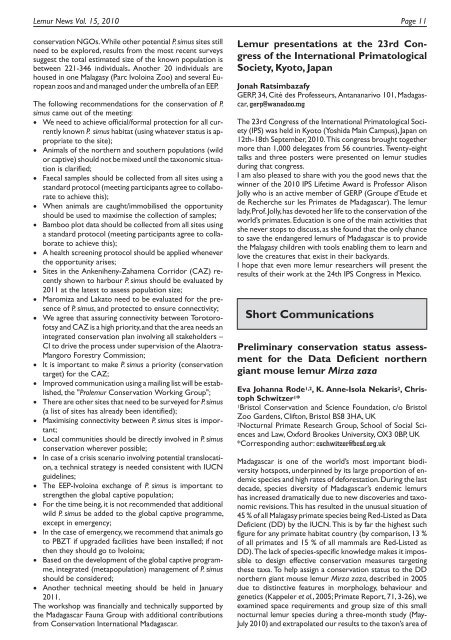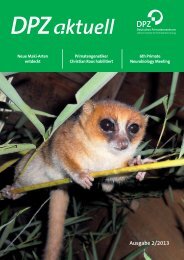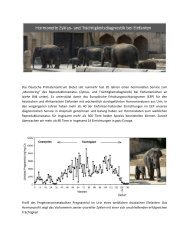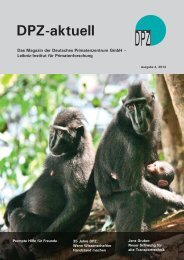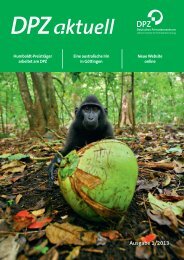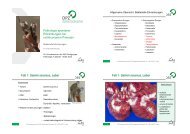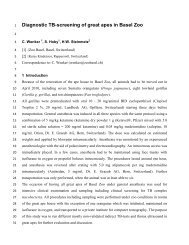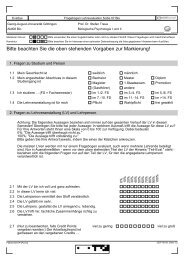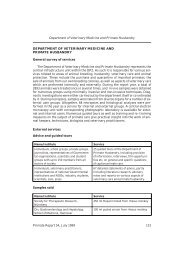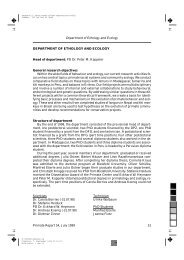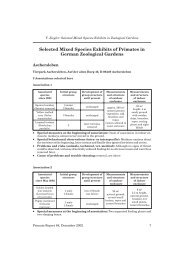Vol. 15 - Deutsches Primatenzentrum
Vol. 15 - Deutsches Primatenzentrum
Vol. 15 - Deutsches Primatenzentrum
You also want an ePaper? Increase the reach of your titles
YUMPU automatically turns print PDFs into web optimized ePapers that Google loves.
Lemur News <strong>Vol</strong>. <strong>15</strong>, 2010 Page 11<br />
conservation NGOs.While other potential P.simus sites still<br />
need to be explored, results from the most recent surveys<br />
suggest the total estimated size of the known population is<br />
between 221-346 individuals. Another 20 individuals are<br />
housed in one Malagasy (Parc Ivoloina Zoo) and several European<br />
zoos and and managed under the umbrella of an EEP.<br />
The following recommendations for the conservation of P.<br />
simus came out of the meeting:<br />
We need to achieve official/formal protection for all currently<br />
known P. simus habitat (using whatever status is appropriate<br />
to the site);<br />
Animals of the northern and southern populations (wild<br />
or captive) should not be mixed until the taxonomic situation<br />
is clarified;<br />
Faecal samples should be collected from all sites using a<br />
standard protocol (meeting participants agree to collaborate<br />
to achieve this);<br />
When animals are caught/immobilised the opportunity<br />
should be used to maximise the collection of samples;<br />
Bamboo plot data should be collected from all sites using<br />
a standard protocol (meeting participants agree to collaborate<br />
to achieve this);<br />
A health screening protocol should be applied whenever<br />
the opportunity arises;<br />
Sites in the Ankeniheny-Zahamena Corridor (CAZ) recently<br />
shown to harbour P. simus should be evaluated by<br />
2011 at the latest to assess population size;<br />
Maromiza and Lakato need to be evaluated for the presence<br />
of P. simus, and protected to ensure connectivity;<br />
We agree that assuring connectivity between Torotorofotsy<br />
and CAZ is a high priority,and that the area needs an<br />
integrated conservation plan involving all stakeholders –<br />
CI to drive the process under supervision of the Alaotra-<br />
Mangoro Forestry Commission;<br />
It is important to make P. simus a priority (conservation<br />
target) for the CAZ;<br />
Improved communication using a mailing list will be established,<br />
the "Prolemur Conservation Working Group";<br />
There are other sites that need to be surveyed for P.simus<br />
(a list of sites has already been identified);<br />
Maximising connectivity between P. simus sites is important;<br />
Local communities should be directly involved in P. simus<br />
conservation wherever possible;<br />
In case of a crisis scenario involving potential translocation,<br />
a technical strategy is needed consistent with IUCN<br />
guidelines;<br />
The EEP-Ivoloina exchange of P. simus is important to<br />
strengthen the global captive population;<br />
For the time being,it is not recommended that additional<br />
wild P. simus be added to the global captive programme,<br />
except in emergency;<br />
In the case of emergency, we recommend that animals go<br />
to PBZT if upgraded facilities have been installed; if not<br />
then they should go to Ivoloina;<br />
Based on the development of the global captive programme,<br />
integrated (metapopulation) management of P. simus<br />
should be considered;<br />
Another technical meeting should be held in January<br />
2011.<br />
The workshop was financially and technically supported by<br />
the Madagascar Fauna Group with additional contributions<br />
from Conservation International Madagascar.<br />
Lemur presentations at the 23rd Congress<br />
of the International Primatological<br />
Society, Kyoto, Japan<br />
Jonah Ratsimbazafy<br />
GERP, 34, Cité des Professeurs, Antananarivo 101, Madagascar,<br />
gerp@wanadoo.mg<br />
The 23rd Congress of the International Primatological Society<br />
(IPS) was held in Kyoto (Yoshida Main Campus),Japan on<br />
12th-18th September, 2010. This congress brought together<br />
more than 1,000 delegates from 56 countries. Twenty-eight<br />
talks and three posters were presented on lemur studies<br />
during that congress.<br />
I am also pleased to share with you the good news that the<br />
winner of the 2010 IPS Lifetime Award is Professor Alison<br />
Jolly who is an active member of GERP (Groupe d’Etude et<br />
de Recherche sur les Primates de Madagascar). The lemur<br />
lady,Prof.Jolly,has devoted her life to the conservation of the<br />
world’s primates. Education is one of the main activities that<br />
she never stops to discuss,as she found that the only chance<br />
to save the endangered lemurs of Madagascar is to provide<br />
the Malagasy children with tools enabling them to learn and<br />
love the creatures that exist in their backyards.<br />
I hope that even more lemur researchers will present the<br />
results of their work at the 24th IPS Congress in Mexico.<br />
Short Communications<br />
Preliminary conservation status assessment<br />
for the Data Deficient northern<br />
giant mouse lemur Mirza zaza<br />
Eva Johanna Rode 1,2, K. Anne-Isola Nekaris 2, Christoph<br />
Schwitzer 1*<br />
1Bristol Conservation and Science Foundation, c/o Bristol<br />
Zoo Gardens, Clifton, Bristol BS8 3HA, UK<br />
2Nocturnal Primate Research Group, School of Social Sciences<br />
and Law, Oxford Brookes University, OX3 0BP, UK<br />
*Corresponding author: cschwitzer@bcsf.org.uk<br />
Madagascar is one of the world’s most important biodiversity<br />
hotspots, underpinned by its large proportion of endemic<br />
species and high rates of deforestation.During the last<br />
decade, species diversity of Madagascar’s endemic lemurs<br />
has increased dramatically due to new discoveries and taxonomic<br />
revisions. This has resulted in the unusual situation of<br />
45 % of all Malagasy primate species being Red-Listed as Data<br />
Deficient (DD) by the IUCN. This is by far the highest such<br />
figure for any primate habitat country (by comparison, 13 %<br />
of all primates and <strong>15</strong> % of all mammals are Red-Listed as<br />
DD).The lack of species-specific knowledge makes it impossible<br />
to design effective conservation measures targeting<br />
these taxa. To help assign a conservation status to the DD<br />
northern giant mouse lemur Mirza zaza, described in 2005<br />
due to distinctive features in morphology, behaviour and<br />
genetics (Kappeler et al., 2005; Primate Report, 71, 3-26), we<br />
examined space requirements and group size of this small<br />
nocturnal lemur species during a three-month study (May-<br />
July 2010) and extrapolated our results to the taxon’s area of


